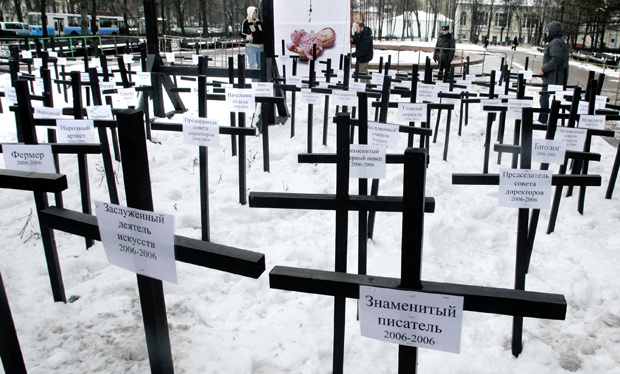Abortion politics in Russia fraught with fears over population decline
By

Abortion politics in Russia fraught with fears over population decline
By
This episode of Worldview was originally broacast on August 11, 2011.
This week, to gain insights into this country’s incredibly polarizing debate over abortion, we’re looking at how reproductive issues play out around the world. It’s part of our occasional series Here, There, where we compare U.S. policy on tough issues to those of other countries.
Russia has one of the highest rates of abortion in the world: 53.7 abortions per 1,000 women between the ages of 15 and 44, according to recent UN statistics. Those numbers, while grim, are much lower than statistics from the Soviet era. In the 1980s, there were 200 abortions for every 100 babies born in the Soviet Union.
In recent years, Russian leaders, worried about the country’s declining population, have increasingly begun to view abortion as a threat to national security.
Today, we discuss Russia’a tumultuous history with Michele Rivkin-Fish, a professor of cultural anthropology at the University of North Carolina in Chapel Hill and author of the book Women’s Health in Post-Soviet Russia. She says the story begins in 1920, when the Soviet Union became the world’s first state to allow women to terminate unwanted pregnancies.
On abortion in the early Soviet era:
“Abortion came to be seen by policy makers as necessary for mobilization of women into the workplace. It was not intended as giving women choice or rights to their body.”
“Motherhood was seen as an important act of citizenship and that you were giving birth to babies who would be future Soviet citizens.”
“The government provided childcare, housing and employment. They felt that since they were providing support, there was no reason women should control their fertility.”
“They did not make contraceptives available and that was the founding contradiction of women’s reproductive health in the Soviet Union that in some ways continues till today, so abortion became the main means of controlling your fertility. The Soviets did not produce condoms and contraceptives in the market because they didn’t want to promote fertility control.”
On rhetoric:
“Stalin put into place this idea of the ‘heroine mother.’ Any women that gave birth to more than five children was given an award and extra benefits, a larger place to live and extra monetary allowances to help take care of the children. The ‘heroine mother’ was a part of the Soviet propaganda, which many women did not buy into.”
“In 1955, Nikita Khrushchev came into power and legalized abortion because he recognized that women were dying in mass from illegal abortions. But he was also concerned with the rise of the birth rate, so he instructed the physicians and public health people to step up the fight against abortions. Public health campaigns and literature called abortions harmful, a selfish rejection of motherhood, a shameful decision, and warned women that they would become sterile.”
“Russia never saw a rise in birth rate. In fact, they were on the course of a big decline. This shaped much of the propaganda that followed.”
“…but economic conditions drove women — then and today — to choosing to have just one child…conditions like communal living…five or six families sharing one kitchen and a toilet.”
Modern conditions:
“Today, there is no censorship on sex in the public sphere or on literature, sexual education or contraceptives.”
“Since 1995 there has been a significant decline in the numbers of registered abortions, due to the availability of contraceptives. Eighty-four percent of women are using some form of contraceptive. This is a huge change from the Soviet era.”
“There are also educational programs being offered by very progressive-thinking doctors and educators. These are offering kids and young adults information about how to control their fertility, how to have timely pregnancies, methods of abortion…but these groups are under scrutiny by the government, so they are always in a vulnerable position.”
“As women are still choosing to have fewer children, in 2006, Vladimir Putin established a new program called the Maternity Capital program. It gives a substantial amount of money — the equivalent of $10,000 — to women who choose to have a second or third child.”
“The government’s agenda is to get women to have more babies. But this doesn’t necessarily take into account women’s reproductive rights or issues.”
Compared to the U.S.:
“There’s not the same kind of abortion rights movement in Russia as in the U.S. Partly that is because it’s very difficult to publically argue that women should have the ‘right to abort.’ Abortion is seen as a symptom of the lack of a choice. It’s not considered a positive right by really any one.”
“Abortion is seen as a necessary legal procedure, not a woman’s right to choose. They are trying to reduce women’s reliance on abortion to improve women’s health.”
“There are groups of doctors, demographers and educators who are very concerned that women’s access to abortion is being restricted, which could lead to dangerous underground abortions. Their efforts are aimed at increasing the use and availability of contraceptives.”
“Even though things are getting better in the overall abortion rate, the percentage increase in attempts to self-induce abortions in the last decade is a very ominous sign that women do not feel that they can get enough information and access in a timely manner.”